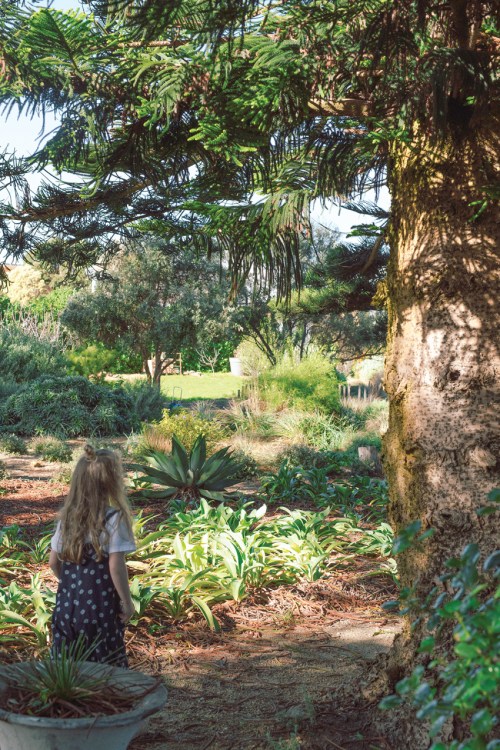In the alkaline soils of the Limestone Coast, South East communities have learnt valuable lessons about curating successful beachside gardens.
Making the most of the coast
From the coast to the border, the beautiful lower South East boasts rich farming land, large stretches of pine forests, incredible limestone caves, famous Coonawarra and Limestone Coast wine regions and pretty coastal villages.
Coastal gardens from Kingston to Port Macdonnell have similar challenges with the alkalinity of their sandy soils. The limestone in this region generally lies between 10cm to 40cm below the surface and has a large influence on which plants will thrive in these conditions.

One of the first steps to understanding your soil is to test its pH. Begin by selecting samples of soil from about 10cm below the surface. Be sure to take soil from different areas of the garden, labelling each sample before taking them to your local garden centre where it can be tested or where you can purchase a pH test kit. It’s a simple test and the results will help you to decide which plants are appropriate for your soil.
Lower the pH levels by adding compost and mulch or adding iron chelate or powdered sulphur to the soil. However, a simpler solution is to choose from the surprisingly large range of plants suited to the coast. These plants can usually tolerate salty winds and sandy soil that contains fewer nutrients.

Indigenous plants growing in the dunes and close to the sea such as the unique Leucophyta brownii (Silver Cushion Bush) are perfect for front-line gardens. The silver cushion bush is also available as a dwarf variety or as a sprawling low shrub. The silver foliage is the key to surviving the harshness of the coastal conditions which is why varieties of lavenders, santolina, teucrium, saltbush, adenanthos, leptospermum and eremophila all shine in coastal gardens.
These varieties will not only survive the conditions but also nicely reflect the native grasses and shrubs that cover the dunes.
Grasses give movement and grace to the coastal garden and there are many varieties that will tolerate the high pH and sandy conditions. Varieties of miscanthus such as Miscanthus transmorrisonensis – which features in the garden at Robe’s Moorakyne House – have tall semi-weeping flowers in summer and move in the region’s consistent winds.

There are many alkaline-loving varieties, but for brilliant colour the absolute best plant is Limonium perezzi (Statice). The brilliant blue papery flowers are long lasting and look amazing when planted on mass. Dwarf Kniphofia send up cone-shaped flowers above their strappy leaves in gorgeous hues of orange, red, yellow and lime while the stunning native Correa love limey soil and their toughness makes them valuable to gardens on the coast.
With attractive flowers that seem to go on forever, Eremophilas are tough, hardy coastal plants while Armeria varieties are great edging plants with clumpy leaves that are lush all year. The bright and pastel pink ball-shaped flowers are prolific and long lasting.

Creating shelter or planting screening shrubs or hedges is possible in alkaline soils by choosing plants such as Grevillea olivacea varieties. These extremely tough plants grow quickly into dense shrubs which attract birds. The alkaline-loving Viburnum tinus is a popular choice for a medium sized hedge while Westringia fruticosa is a silver/blue-foliaged alternative. Over recent years, the dwarf form Westringia (Aussie box) has become a very popular choice for formal low hedges.
The perfect complement to the Aussie box is the Westringia fruticosa (grey box), which has a very compact form. They are both extremely tough and drought tolerant and their silver foliage makes an attractive addition to the coastal garden. These plants can be hedged and shaped easily or naturally grow in a neat round shape.

Dwarf variety Leptospermum (Foreshore) has also become a favourite in recent times due to its success growing in the harshest of conditions, the attractive soft grey-green foliage and its suitability for hedging and shaping into neat balls. It is a perfect plant for the seaside where it tolerates salt and dry conditions.
The bright yellow flowers of the Banksia praemorsa (High Noon) are spectacular and the shrub can be a great choice as a windbreak tolerant of salty wind, drought and medium alkalinity. The bonus is beautiful cut flowers for floral arrangements.

Groundcovers suitable for the beach are numerous, ranging from the very unusual Casuarina cousin, to the ground-hugging Myoporum and the many varieties of succulents that can create a visual impact when added to the landscape. Lavenders love Mediterranean conditions similar to the South East region and are commonly used in beachside gardens. Rosemary varieties flower brilliantly and grow effortlessly in alkaline soils and geraniums are still a good choice for well-drained soil and hot, dry positions.
Agonis flexuosa varieties thrive in coastal winds and sandy soil with some varieties providing a beautiful weeping habit. As its name suggests, burgundy agonis has spectacular dark burgundy foliage and is perfect as a feature tree in the coastal garden.

From the tallest plant to the lowest, it’s possible to find a suitable plant to manage both alkaline soils and harsh salt winds while satisfying the desire for a beautiful garden design that suits your home and your needs.



